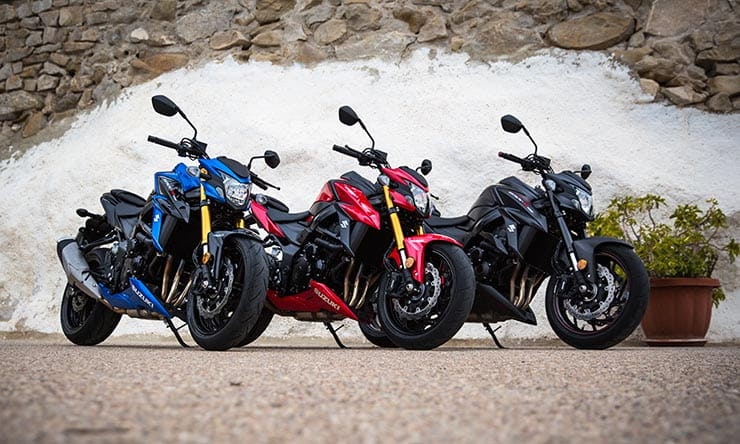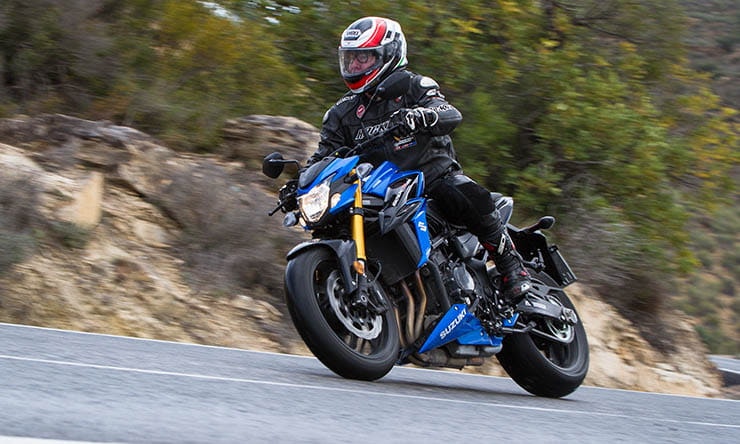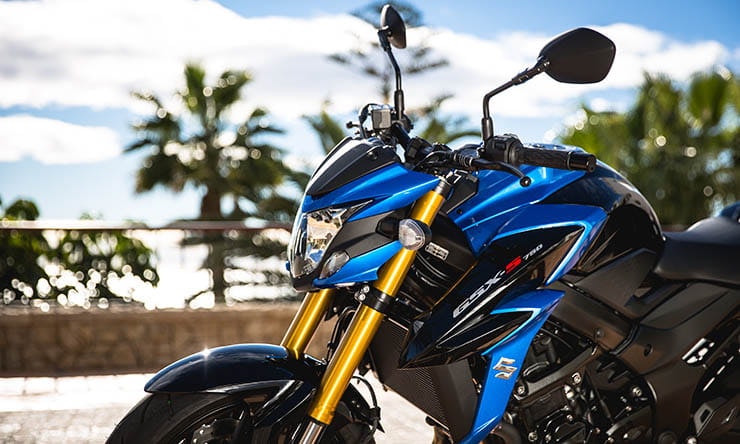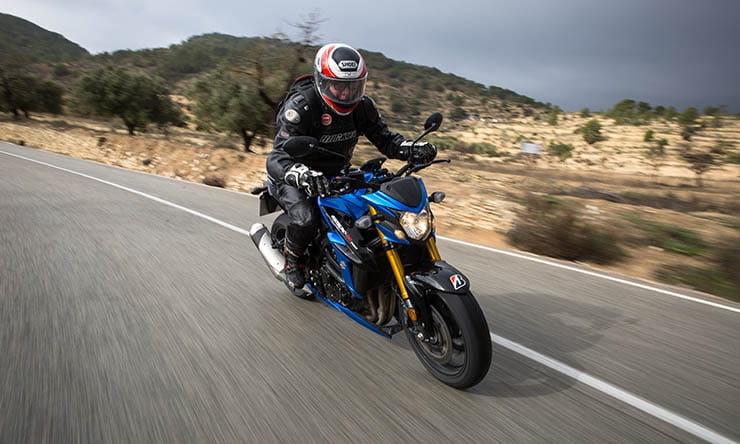Any bike that is reasonably light, claims 112.6 bhp of power and is graced with precise steering is going to be a lot of fun to ride. With what probably equates to a touch over 100 bhp at the rear wheel the Suzuki GSX-S 750 does not disappoint.
In weather conditions ranging from bad to very bad, through to bloody awful, I covered a 100 miles on some wonderful roads in the vicinity of Benidorm in southern Spain and had a ball.
This bike, a replacement for the GSR 750, ticks the boxes that its predecessor left blank. The engine is more powerful and, importantly, more responsive. Wring its neck and it flies. Treat it gently and it's as docile as a sleeping cat.
The power plant is a variant of the engine first fitted to the 2005 GSX-R750 and which also saw service in the GSR. It's been changed to bring it up to date and compliant with the latest Euro4 regulations. The main difference is the reduction in the pumping losses incurred as the pistons descend, pushing air before them. To decrease these losses, the cylinder block, which is cast integral with the upper crankcase, has large ventilation holes at the bottom of each cylinder.
The 4-2-1 exhaust has balance pipes between the outer pair of cylinders and the inner pair, which Suzuki say have allowed them to tune the pressure waves in the exhaust to optimise power output by keeping more of the unburnt charge inside the combustion chambers during the valve overlap period. The obligatory catalytic converter is shared with the GSX-S1000 but the exhaust control valve has been dispensed with, as the changes to the system have made it and its control gear redundant. As well as removing a layer of complication, this absence helps keep some fat off.
An additional two holes have been added to the fuel injectors, bringing the total to ten per unit, while the airbox has sprouted a couple of extra holes to suck in more air.
These changes have allowed a useful increase in power over the previous incarnation while complying with the increasingly tough emissions regulations.
Out on the road, the changes add up to an engine which is fun to use. A 750cc four is an excellent configuration for the street. It has more than enough power to be fun, enough to satisfy an experienced rider but for a newer rider, perhaps stepping up to a big bike for the first time, it is less intimidating than some of the bigger beasts in the transport jungle.
The traction control, which boasts three levels plus an 'off' option, regulates the power output without reducing the overall power. Switch to zero and it will fly hard enough to fulfill most folks' needs. The weather in Spain was so wet that I left the system on level three, where it gives the most intervention. It's unobtrusive and reassuring, taking over from your brain by altering the ignition timing and restricting air delivery when things begin to slip. An amber light on the right hand side of the LCD instrument display flashes to tell you when the TCS is cutting in. It's smooth.
Traction control is a great boon. Anything which frees up brain space on the move has to be a good thing. It won't save you from idiocy of course. It may sample the conditions every four milliseconds but if you enter a corner too quick you'll still be getting friendly with the tarmac. It won't help when the front tyre starts to slide.
Switching between the three modes is easy. A rocker switch and a selector button on the left-hand side of the handlebar take care of everything, and the active mode is displayed on the LCD instrument panel.
The engine control system also has a low rpm assist function called Idle Speed Control (ISC). ISC cuts in to prevent stalling when moving off or riding very slowly. I didn't notice it at all, so I guess it was doing its job quietly and efficiently in the background.
The tubular steel frame comprises a mixture of D section and round tubing and is unchanged from the GSR model. The tapered swingarm is new and the wheelbase is 5mm longer than before. Suspension front and rear is adjustable for spring preload only. For compression and rebound, you get what you're given. Tyres are the new Bridgestone S21s.
It's not easy to evaluate handling in the pouring rain but following a spirited group leader through the tight mountain roads near Alicante was brilliant fun. The steering is quick and stable, flicking from side to side with the lightest pressure on the tapered bars. On longer faster corners the stability was good.. At the very end of the ride we finally found some almost dry roads where we could let rip a little. Sadly there were no challenging corners to be found but the couple of long sweepers we did encounter makes me think that the GSX-S will be a grin in the dry. It was pretty damn good in the wet. Fortunately, I love riding in the rain.
The Bridgestone S21 tyres worked well on the soaking roads. They gave huge confidence and the wet grip was so reassuring that it made hustling along a pleasure. They give good feedback too and give plenty of warning when your imagination starts to exceed you ability. The couple of slides I did have were telegraphed back to me long before they became scary. Stability under heavy braking was equally good. We couldn't test the dry performance much but there is no reason to believe that they will be anything less than ultra competent.
You have to love ABS. The first ABS equipped bike I rode was the 2010 Honda Fireblade and I was an instant convert. I fail to understand why people complain about it, although I would agree with those who dislike the fact that all new bikes have to have it by law.
Suzuki GSX-S750 official promo film
Suzuki's official promo film for the 2017 GSX-S750
The Suzuki take on ABS is as good as you'll find. You can feel it working but it does not detract from the experience of riding. It still makes me grin to squeeze the front brake as hard as I can in the wet and stamp on the rear with an equal lack of sensitivity. It's one less thing to worry about leaving you more mental capacity to concentrate on the important business of staying alive. The system samples the wheel speed 50 times for each rotation, while four pot opposed piston Nissin calipers bite on 310mm diameter petal pattern discs up front and have a lovely feel. The rear brake is similarly competent. There is no cornering ABS, so trail and mid corner braking is still a matter of using your skill and judgment.
The riding position is aggressive and has you leaning forward. It feels as though it may be uncomfortable when you first sit on the bike but on the move, it is just right.
Rider comfort is good. I could spend all day in the GSX-S saddle and not feel bothered by it. The small surround enclosing the headlight diverts a surprising amount on the oncoming air away from your upper body.
Styling is always a personal thing. I would be quite pleased to roll up my workshop door and see this device inside. It's a good looking machine.
2017 Suzuki GSX-S750 - Verdict
This is a real do-it-all bike and it will do it all well. Ride it to work, go for a weekend B road blast, whack a bit of luggage on and take it on holiday. It's manageable enough for your first track day in the novice group but I would also quite happily take it out in the fast group without (too much) fear of disgracing myself. More demanding riders may want to tweak the suspension and I am sure it will only be a matter of time before K-Tech produce a cartridge kit for it so you can fiddle with compressions and rebound to your heart's content. There will already be aftermarket shocks out there to take care of the rear. Other than that, and those changes are not essential, the bike is good to do whatever you want it to do from day one.
Whether you go for it depends on what flavour your prefer for your middleweight naked motorcycle. At £7599 for the blue and red options and £7799 for the matt black model, it is competitive on price with the competition.
There are a couple of three cylinder options at that price level, the hugely capable Yamaha MT-09 and the forever delightful Triumph Street Triple made even more desirable by the upcoming new 765 cc engine.
If you have big money to spend, the eye wateringly gorgeous and dynamically competent MV Agusta Brutale will deliver all you can use and more.
If you prefer a twin and you like the whole Ducati thing, the 821 Monster is waiting for you.
All put out about the same power - expect to see around 100 bhp at the rear wheel at your local dyno shop. I still do not get why manufacturers quote the eternally irrelevant crankshaft end figures. They mean nothing. If the crank is putting the power direct to the road, after all, it means you've crashed and worn through an engine casing. Your overriding concern will be for the state of your body and your wallet.
In my opinion, 100 bhp is plenty for the road and for having fun on the track. Anything over 120 bhp is wasted on most people except in war of bragging rights.
I would happily consider adding this bike as a slightly more practical alternative to my KTM RC8 R, and it would be kinder to my license as well.
I'm looking forward to seeing how it goes over a few days on dry roads later this year.
You can start queuing at your local Suzuki dealer from mid-March when the bike, dubbed 'The Apex Predator' by Suzuki, is due to arrive in the UK.
I'm not sure about the name but I am certain about the bike. It's good. Nice one Suzuki.
Postscript
Suzuki has confirmed a £99 PCP offer for the GSX-S750. With a deposit or trade-in worth £1,735.33, one can be ridden away for £99 per month over 37 months, with a final repayment or guaranteed future value of £3,729.00.
2017 Suzuki GSX-S750 – Specifications
Engine and Transmission
Type: Liquid cooled, four-stroke, double overhead camshaft, 16 valve, in-line four cylinder
Capacity: 749 cc
Bore x Stroke: 72.0 x 46.0 mm
Compression Ratio: 12.3:1
Maximum Power: 112.6 bhp @ 10500rpm (114.21ps)
Maximum Torque: 59.74lb.ft @ 9000rpm (81.00N.m)
Exhaust: Four into one with catalytic converter
Final Drive: Chain
Clutch: wet, multiplate
Gearbox: Six speed
Chassis
Frame: Mixed D section and round section steel tube
Swingarm: Box section aluminium alloy
Front Wheel: 17 inch diameter ten spoke cast aluminium alloy
Rear Wheel: 17 inch diameter ten spoke cast aluminium alloy
Front Tyre: 120/70ZR17 (58W)
Rear Tyre: 180/55ZR17 (73W)
Front Suspension: Inverted telescopic fork, adjustable preload
Rear Suspension: Single damper, seven position adjustable preload
Front Brake: Twin petal pattern disc, four piston radial caliper
Rear Brake: Single petal pattern disc, single piston sliding caliper
Instrument Display/Functions: LCD instrument panel, adjustable brightness, traction control, gear position indicator, fuel consumption, range
Colours: Blue, Red, Black
Dimensions
Length: 2125mm (83.7in)
Width: 785mm (30.9in)
Height: 1055mm (41.5in)
Seat Height: 820mm (32.3in)
Wheelbase: 1455mm (57.3in)
Rake: 25° 20'
Trail: 104mm (4.1in)
Wet Weight: 213kg (469.6lbs)
Fuel Tank Capacity: 16 litres (3.5 UK gallons)
Fuel Consumption: 57.6mpg
Price: £7,599 (Blue and Red) £7,799 (Black)
Available: Early March 2017



